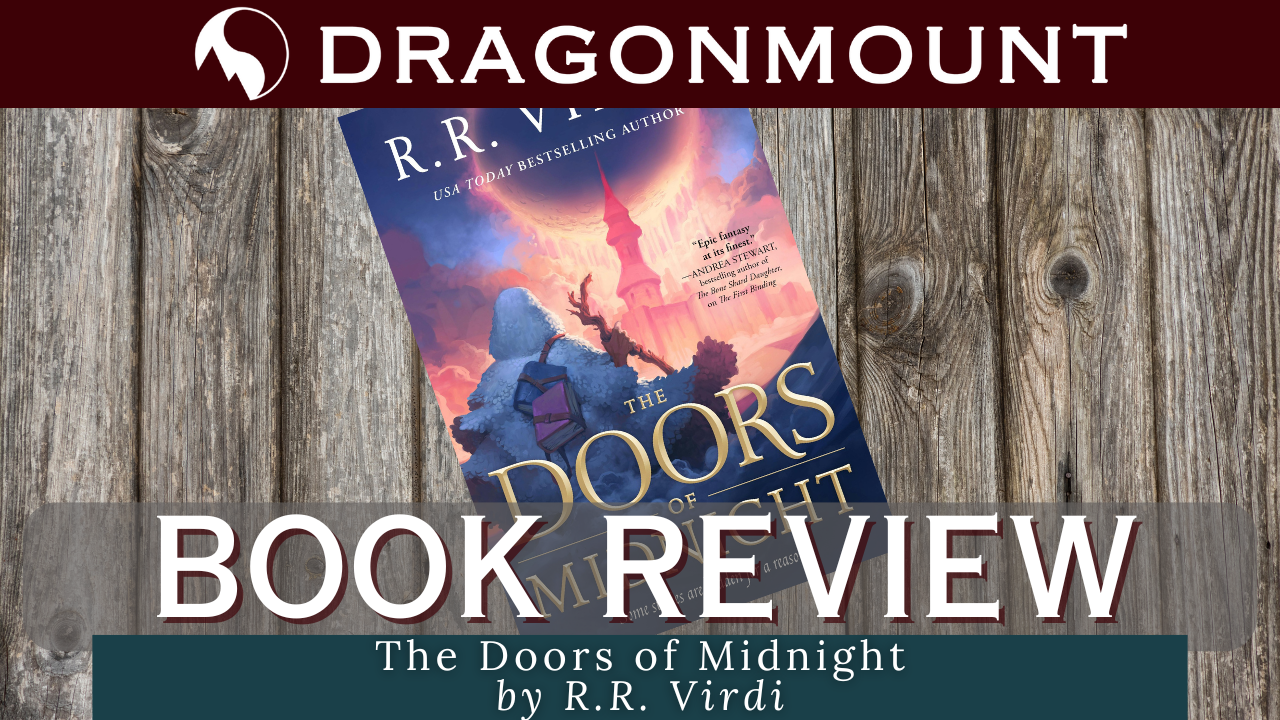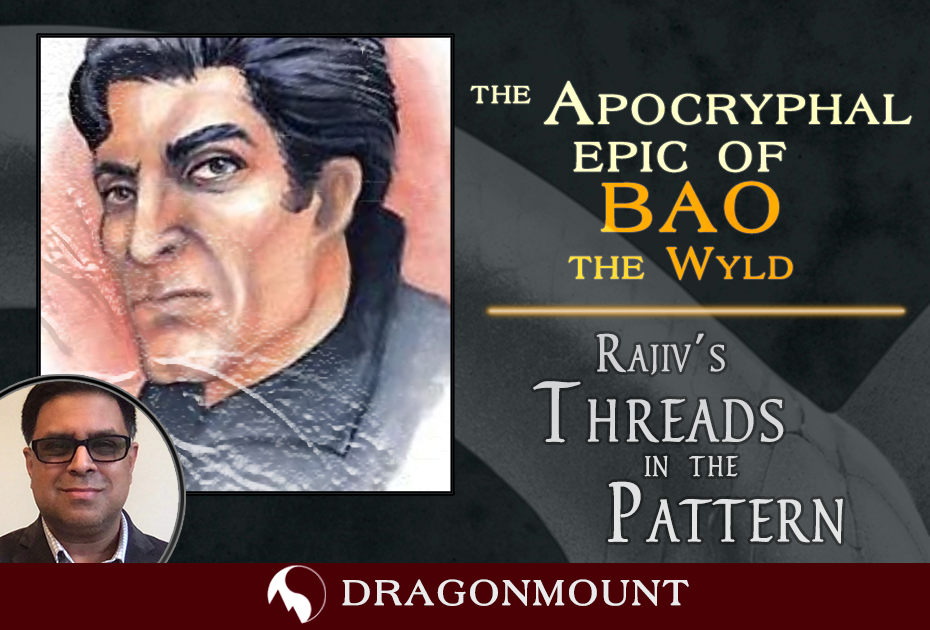-
Posts
68 -
Joined
Content Type
Profiles
Forums
Store
Gallery
Blogs
News
Downloads
Events
Everything posted by MahaRaj
-

Rajiv's Threads In the Pattern: The Apocryphal Epic of Bao the Wyld
MahaRaj commented on MahaRaj's news item in Books and eBooks
The revelation is in A Memory of Light chapter 22, "The Wyld." -
Rajiv Moté is Dragonmount’s book blogger with a lens on the craft of fiction writing. When he’s not directing software engineers, he writes fiction of his own, which can be found cataloged at his website. “A thing is a thing, not what is said of that thing.” This mysterious quotation from the movie Birdman claims that there is a reality that exists apart from the narratives we weave around reality. On its face, that’s obvious. But in an age when narrative shapes perception, and perception manifests reality, it’s a radical rebuttal to what some call a post-truth era, in which those who control the narrative control reality. We need narratives. Stories are how we make sense of the world. But the more emotionally compelling the story, the less it needs to conform to the nuts-and-bolts of reality. Our beliefs are a filter that shapes our truths. There is both power and danger in that. We must remind ourselves that all stories have a teller. How far we trust a given storyteller is up to us. Stories are a kind of magic—we must be mindful of who's casting the spell. The Doors of Midnight, just released in August 2024, is the second volume of R.R. Virdi's Tales of the Tremaine, a Silk Road epic fantasy that is all about stories and how they shape and are shaped by reality. The books follow Ari, a traveling storyteller and student of magic, across two timelines in a story-within-the-story (with many more nested stories). In the present, adult Ari is not only a storyteller, but The Storyteller, whose carefully cultivated reputation precedes him and grants him access to the wealthy and powerful. This is useful, because he’s hunting demons masquerading as the wealthy and powerful. His path keeps crossing with a mysterious beauty called Eloine who wants nothing more in life than to listen to Ari tell her his life's story and unburden himself of his troubles. And he does! With enthusiasm! This is the inner story of Ari's adventurous youth as a student of magic, a collector of folklore, a pursuer of the demons who killed his adoptive family, a prince of thieves, a cloaked vigilante, a spy for a desert warlord, an apprentice to a mystic, an apprentice to a demigoddess—and more. Ari had a busy youth, but he keeps himself no less busy as an adult, playing politics, investigating nobles, searching for obscure texts, getting involved with assassination plots, and always—always—telling people his story. Ari absolutely loves telling his own story, spreading rumors about himself, and knowing that people are talking about him. Ari, past and present, is an incredible narcissist. It's a trait that is integral to the theme: Ari is preoccupied with (re-)inventing himself through stories, but in doing so, may be locking away truths about himself that he must someday face. That day of reckoning never happened in the chunky previous book, The First Binding, nor did it happen in the likewise hefty The Doors of Midnight. For me, it became tiresome. This could be a coming-of-age story, but Ari never really matures out of his self-absorption. This could be a self-discovery story, but the lessons of Ari's myriad adventures seem short-lived. This could be a quest for vengeance, but Ari never seems to get any closer. Not yet, anyway. Maybe in the next volume. So what kind of story is it? The Doors of Midnight, like its predecessor, ends up being a collection of adventure tales, loosely strung together. This, too, is no accident. R.R. Virdi is a scholar of folk tales and how they morph and merge as they travel. Characters and events conflate, fragment, or get repurposed. They become canon here, apocrypha there. Ari, The Storyteller, is crafting a legend about himself. Tales of the Tremaine is a quilt of episodic patches with an organizing theme and a potential reckoning on the distant horizon. Unfortunately, the question also arises: how much longer will we care? The story references Scheherazade and her narrative tease of stretching out her story for a thousand-and-one nights, but The Doors of Midnight is unfortunately less capable of keeping us breathless for what happens next. Though there are some scenes of beauty and wit, for me, it was often a slog to get through the weighty tomes of this saga. Part of my problem is that, despite having the lofty title of The Storyteller, Ari isn't a storyteller that trusts his audience to get the point. He will present a lovely image, heavy with implication, and then spend the next paragraph or more explicating it. Ari can't leave anything unspoken. He needs to narrate, pontificate, repeat himself, expound on meaning, and offer his wise insights—but they aren't all that deep. The adult Ari, who is ultimately the narrator of both past and present timelines, still reads like a young person sounding out his own thoughts and treating them with a self-important gravitas that an older reader might find unwarranted and tedious. It is, unfortunately, the prevailing style of the narration. By contrast, the best parts of the book are when Ari learns that other characters (usually women) have internal lives, his assumptions about them have missed the mark, and their stories are perhaps more interesting than his own. These breaks from narcissism into humility make Ari sympathetic and human—for as long as they last. Ari learning to listen is actually a plot point, though it's unevenly applied. Sadly, these lessons occur in the narrated past, and Ari-the-narrator shows no signs of having grown from them. The magic in this saga is compelling and gets right to the heart of the thematic intersection of reality and stories. Imagine a multiverse where anything is possible within the logic of a story. Practitioners of the magic in this world envision their version of the story and bind it to reality. They impose their narrative on the world. It's an amazing metaphor, which hasn't yet been used to its full effect, but there are hints that this is coming. Stories can be used not only to create a reality, but to hide one, and this story drops hints that the key to Ari defeating his demonic enemies (and discovering his own birthright power) is in discovering the truth hidden behind the stories—or perhaps discovering the true story beyond what others have imposed onto reality. Fans of metafiction like me are champing at the bit to see the promise of this idea realized. This book tells us R.R. Virdi is still making the promise, but we don't see it fulfilled just yet. There are enough similarities between Virdi's Tales of the Tremaine and Patrick Rothfuss’s The Kingkiller Chronicles that one could wonder if Virdi's saga is a viable replacement for the Rothfuss story that may never be completed. Beside the myriad details that map directly to one another, both are ultimately tales that the narrator is telling about himself that call for a healthy dose of skepticism by the reader. Alas, while the elements of the two series have a lot of overlap, Virdi's approach to storytelling doesn’t scratch the same itch. With Rothfuss, there is enough of a difference between youthful and adult Kvothe that it sparks a mystery around the unreliable narration and the character’s Mary Sue-ness. With Virdi, I feel like I’m granting Ari the benefit of the doubt, and hoping for a payoff. The difference is the strength of the through-line, which in Rothfuss seems to build, but in Virdi, feels deliberately diffuse, like a collection of folk tales. I admire the cultural anthropology of Virdi’s approach, but I’m more drawn into the narrative momentum of Rothfuss’s story. I’d have enjoyed The Doors of Midnight more if only Ari’s storytelling lived up to his self-appointed title as The Storyteller.
-

Rajiv's Threads In the Pattern: The Apocryphal Epic of Bao the Wyld
MahaRaj posted a news item in Books and eBooks
Rajiv Moté is Dragonmount's book blogger with a lens on the craft of fiction writing. When he's not directing software engineers, he writes fiction of his own, which can be found cataloged at his website. SPOILERS for all things related to Demandred. One of the most dramatic and exciting single-book plot arcs in The Wheel of Time was in Lord of Chaos. Rand al’Thor announces an amnesty for men who can channel the One Power, and a rag-tag group of untrained men, young and old, answer the call. The amnesty also attracts Mazrim Taim, a False Dragon who is cool and confident enough in the face of the Dragon Reborn to propose an equal partnership. Instead, Rand puts him in charge of training the assembled men, and over the course of the book, those men acquire skill, uniforms, ranks, the name “Asha’man,” and an institution: the Black Tower. By the end of Lord of Chaos, they become an elite military unit, rescuing Rand from captivity and crushing both renegade Aiel and Aes Sedai. The balance of power shifts, and the world suddenly becomes more unpredictable and dangerous. The novel is bookended by our first point-of-view sequences from the mysterious Forsaken Demandred. At the beginning, the Dark One summons him to Shayol Ghul to receive secret instructions, and at the end, revels in his apparent success. This framing, along with the details of Mazrim Taim’s mannerisms, made it clear to readers that Demandred had replaced Mazrim Taim and was now in command of Rand’s most powerful army. Robert Jordan’s notes (24:00) confirm that this was the original plan. But sometime before Winter’s Heart, Jordan changed his mind. The details that were originally foreshadowing became red herrings. There’s a burden when using red herrings to mislead readers. The eventual payoff has to be more satisfying than what readers were led to believe. That was a challenge Brandon Sanderson had to take up when he finished the series. When Demandred, calling himself Bao the Wyld, explodes onto the stage in A Memory of Light, he is the most formidable--and most prepared--of the Forsaken. His army of Sharans has the same sort of loyalty as Rand’s Aiel. Their use of the One Power reflects their leader’s long experience of Powered warfare. He wields a sa’angreal mightier even than Callandor. He shows the discipline and focus of a master martial artist, and the skill of the world’s greatest swordsman who does not underestimate an opponent. The rest of the Forsaken look positively frivolous compared to him. What’s better than Demandred in control of Rand’s Asha’man army, disguised as Mazrim Taim? Demandred in control of Rand’s Asha’man through his protégé Mazrim Taim, while bringing into battle another army nobody had foreseen. Fans of The Wheel of Time should consider “River of Souls,” published in the Unfettered charity anthology, essential reading. The short story is a deleted sequence from A Memory of Light set in Shara. It establishes Demandred’s leadership of the Sharans by putting him on a quest to win a missing part of D’jedt, a sa’angreal second only to the Choden Kal. It hints how Demandred became the Sharan’s foretold savior: the Wy-eld. The Dragonslayer. The Demandred pivot from Mazrim Taim to Bao raised questions. How did he command real loyalty, instead of the Compulsion- and deception-based obedience for which his colleagues settled? How did he mobilize the secretive, isolationist Sharans into an army willing to march on a foreign land under the banner of the Shadow? What has this man been up to for the last two years that made him so different from all the other Forsaken? “River of Souls” is an amazing piece of craft. In the space of a short story, it sketches--through allusion and parallels to Rand’s story--an entire epic fantasy running concurrent to The Wheel of Time. As Bao, Demandred had a heroic epic of his own. Demandred nearly falls in love, nearly has friends, and nearly has an arc similar to Rand’s. But instead of learning the hard lesson of reclaiming his humanity by embracing “laughter and tears,” he allowed darkness and hardness to rule him. In his foreword, Brandon Sanderson says that “River of Souls” accomplished its goals too well by introducing too many new elements at the end of a story, and giving a taste of something that will never be sated, setting up too many unfulfilled promises. Bao the Wyld would never get the epic teased by “River of Souls.” It’s a fascinating and insightful calculus. A series has a structure, just as a novel does, and there are things you can’t do when you’re closing a series compared to when you’re opening one. Just as the end must pay off promises made in the beginning, revelations in the end that were never raised as earlier questions feel superfluous, no matter how entertaining. “River of Souls” offered a glimpse at a culture that has a fundamentally different view of the Pattern (the Tapestry, in their parlance) and the Dark One. To Sharans, fate was a shackle, and a victory of the Shadow meant liberation from the repeating destinies that the Wheel wove into the Pattern. The Wheel of Time gives few convincing reasons for a person to pledge themselves to the Dark One, but the Sharans offer a look at a belief system that values self determination over fate, which is the Father of Lies’ promise. But up until A Memory of Light, there was never a question of why an entire culture would follow the Shadow. “River of Souls” sets up Demandred as the most developed and complex of Rand’s adversaries, a more direct opposite number to Rand than Ishamael/Moridin. Perhaps in this, it also succeeded too well. The idea of an anti-Rand, fulfilling prophecies, changing societies, and nearly being a hero on his way to the Last Battle is compelling symmetry. The Wheel of Time contained enough chapters entitled “Threads Woven of Shadow” that it’s not hard to imagine an anti-ta’veren in the Wheel’s cosmology. But Team Jordan’s mission was to finish a story, not launch new directions. The epic of Bao the Wyld must remain apocryphal. “River of Souls” was a great story that came at the wrong time.





